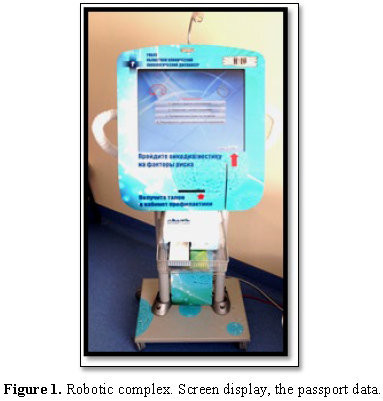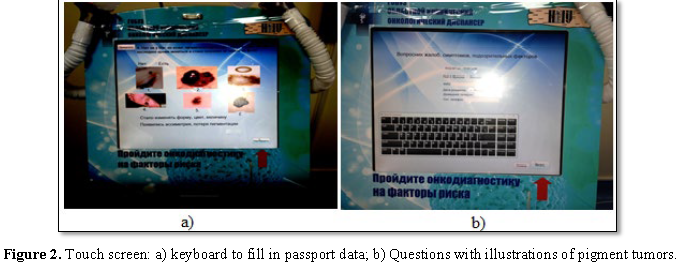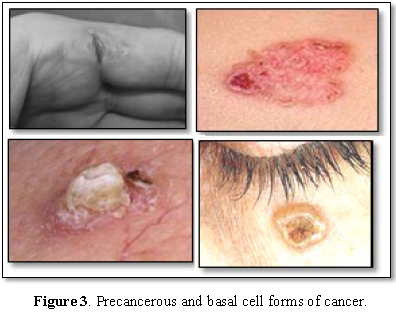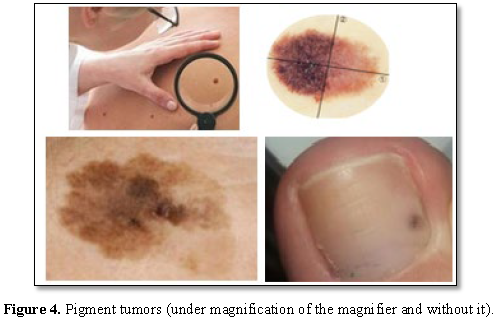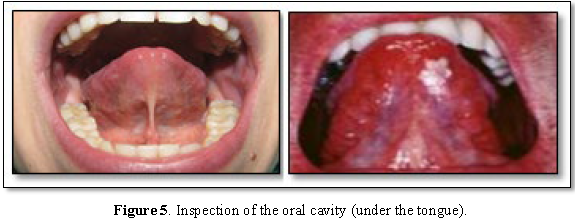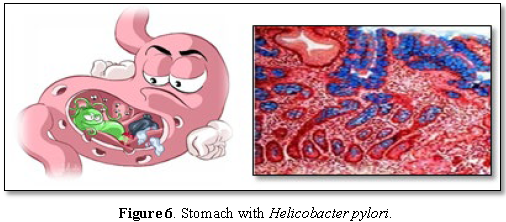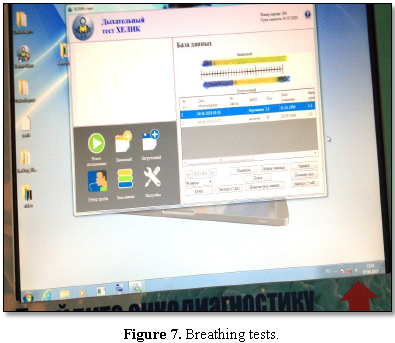640
Views & Citations10
Likes & Shares
On the basis of the created robotic complex with a
program for the survey with illustrations (by type there are no similar forms
of pathology) of major tumors, magnifying, slit lamp, mirror, magnifier on a
flexible basis (sleeves) for examination of the oral cavity. The survey was
conducted in 38 patients with a certain trajectory for men and women on the
touch screen. The use of the robotic complex allowed patients to suspect tumors
of the skin, oral cavity, thyroid gland, lymph node enlargement in 39.4% ±
1.7%, of which 53.4% ± 1.9 with further examination of cancer was confirmed,
including 2 patients with melanoma and 4 basal cell carcinomas. In the presence
of complaints from the stomach, heartburn or belching with a smell on an empty
stomach, 17 patients underwent a “breathing test” (basal and with a load of
urea) on the Helik-Scan of AMA LLC, built into the program of the robotic
complex. The color change in the “breathing tubes” was scanned with fixation on
the touch screen, 7 of them had Helicobacter pylori above 10 units with load.
In 5 patients with FGS, metaplasia (MP-1 and MP-2) was established, in 2
gastric ulcers and one of them with malignancy. After examination of the
patient and processing of the results with a robotic complex, recommendations
for further tactics were sent via the confidential Internet to the doctor of
the prevention Cabinet.
Keywords:
Robotic complex, Survey with illustrations, Breathing test
Although
malignant tumors are extremely diverse and difficult to diagnose, a lot is
known about the risk factors and mechanisms of cancer development, so that in
most cases not only timely diagnosis and treatment, but also taking an active
position in assessing the specific risk, successfully conduct prevention. The
doctor should conduct a systematic examination of the patient not when something
is “sick”, but regularly, when nothing hurts, taking into account the risk
groups, gender and age when referring to the doctor for any reason. Early forms
of cancer are preceded by a long period of carrier of oncogenic viruses,
Helicobacter pylori and dysplasia, which can be established and cure.
Naturally,
asymptomatic pathological processes with this approach against the background
of concomitant diseases go by the wayside. And this is the weakest link of the
primary diagnosis!
The aim is to find a solution to the class of
problems of improving the effectiveness of detection of cancer pathology and
risk factors by using a software package of questions on systems, including the
fundamental knowledge of specialists in a particular field of medicine, providing
advice to less qualified users, Hat is, the creation of digital systems of
artificial intelligence, which precede the reception of the doctor [1,2].
Robotic
intelligence is a technique that allows you to implement algorithms for
multi-purpose and system analysis into the expert program. The theoretical
basis will be logic, illustrations, digital technologies and expertise with
gradual improvement, as was the case with the chess robot.
In our
opinion, a large-format digital television screen should be installed in the
waiting room of the polyclinic, associated with the prevention program
explaining the goals and objectives of the passage of the robotic complex (such
To complete
the survey, we have created a robotic system (Figure 1) with question and illustrations for patients on the
touch.
Then follow
questions on the main localizations with illustrations (melanoma and
non-melanoma) tumors (Figure 2b),
precancerous skin conditions, risk factors and other conditions, organs,
lifestyle and habits.
For example (Figure 3):
1. Do
you have the skin for any sores, cracks or other entities which have recently? 1.
Yes, there are began to change the shape, color or size;
2. Yes,
there was a tumor spreading to the skin, places with raised edges other
changes, sometimes;
3. Itch;
4. Yes,
there is an ulcer on the skin that does not heal for more than 3-4 weeks;
5. Yes,
there is a formation in the form of plaques skin color with a dent in the
center, raised shiny mother-of-pearl edges;
6. Yes,
there are, but do not know how to evaluate 1.6 - a few sign 0. Nothing.
Do You have
a pigment spot(s) in the face, back, neck, including the nail bed (without
injury) or other places, including under magnification? (Figure 4).
Given the extremely high level of advanced
cases of oral cancer, we have mounted movable sleeves with mirrors with an
increase (5 times) and without increase.
For lighting, a slit lamp and disposable spatulas are turned on (Figure 5 - oral examination).
RESEARCH METHODOLOGY AND DISCUSSION
The organizer of the survey is a specially
trained nurse operator, which includes a robotic system and registration code.
The nurse operator helps to answer questions, signs or factors that cause
difficulties in the patient. The trajectory of the survey depends on gender and
clarifying factors. As you know, stomach cancer takes 2nd place
among other malignant tumors.
Given that for the stomach, the proven cause
is Helicobacter pylori, we in the
presence of the slightest complaints from the stomach in the robotic complex
provides a sensitive “breathing test”, which manufactures LLC “AMA” in the form
of “Helik-Scan” (Figure 6).
Two “breathing tests” were performed on an
empty stomach: before taking urea (basal test) and after (with load). In the
case of Helicobacter pylori infection, the second sample (with a load of urea
or urea) significantly increased its blue hue due to an increase in the percentage
of ammonia in the exhaled air, the system automatically reflected on the
screen, compared the change in the length and shade of the second sample and
gives the finished result (Figure 7).
In Figure
7 on the Left in the upper rectangle two yellow strips are visible (the
upper end after basal respiration became blue - 4, 9 units; the lower - after
loading 10, 8 units).
Preliminary tests were conducted in 38
patients, applied to regional clinical Oncology dispensary "open Day"
in GOBUZ OKOD. Application of robotic the complex allowed the patients to
independently identify, suspect or establish tumors of the skin, oral cavity,
thyroid gland, lymph node enlargement in (15 patients) 39.4% ± 1.7, of which (8
patients) 53.4% ± 1.9 with further examination, cancer was confirmed, including
2 patients with melanoma and 4 basal cell carcinoma.
17 patients presenting certain phenomena of
discomfort from the stomach, additionally held a "breath test", 7 of
them discovered helicobacters above 10% load. All patients underwent EGD with
biopsy for atypical cells and Helicobacter pylori for authenticity. 5 patients
have metaplasia (MP-1 and MP-2), 2 gastric ulcers and one of them with malignancy.
After processing the results of all the data
of the robotic complex through the local Internet system, the results and
recommendations were sent to the attending physician, who after further
examination of the patient established the final diagnosis.
CONCLUSION
1. The
preliminary results of the introduction of the robotic complex indicate the
time savings of the “lean” clinic and the active identification of cancer risk
factors, dysplastic processes and early forms of malignant tumors, prevention
and treatment of which is less costly more effective.
2. Conducting
awareness-raising preventive work on digital television screens such as “slide
show” in the halls of clinics increases cancer literacy of patients and the
focus of their medical examinations and the need for screening.
3. This
approach of preliminary complex robotic examination is a real breakthrough in
identifying risk factors for cancer and early forms of tumor diseases, which
requires further improvement.
1.
Application No. 2181388513 0t 17.10.18 in Rospatent of
the Russian Federation for a patent for an invention.
2.
Сherenkov VG, Makarov VA, Petrov AB, Kostyukov AV,
Cherenkov VG, et al. (2018) Ways of creating the artificial Intellect in
education and carrying out the cancer component of medical examination
(screening) of the population. MOJ Tumor Res 1: 136-138.
QUICK LINKS
- SUBMIT MANUSCRIPT
- RECOMMEND THE JOURNAL
-
SUBSCRIBE FOR ALERTS
RELATED JOURNALS
- Journal of Blood Transfusions and Diseases (ISSN:2641-4023)
- Archive of Obstetrics Gynecology and Reproductive Medicine (ISSN:2640-2297)
- Journal of Ageing and Restorative Medicine (ISSN:2637-7403)
- Chemotherapy Research Journal (ISSN:2642-0236)
- International Journal of Radiography Imaging & Radiation Therapy (ISSN:2642-0392)
- Journal of Allergy Research (ISSN:2642-326X)
- Journal of Psychiatry and Psychology Research (ISSN:2640-6136)

